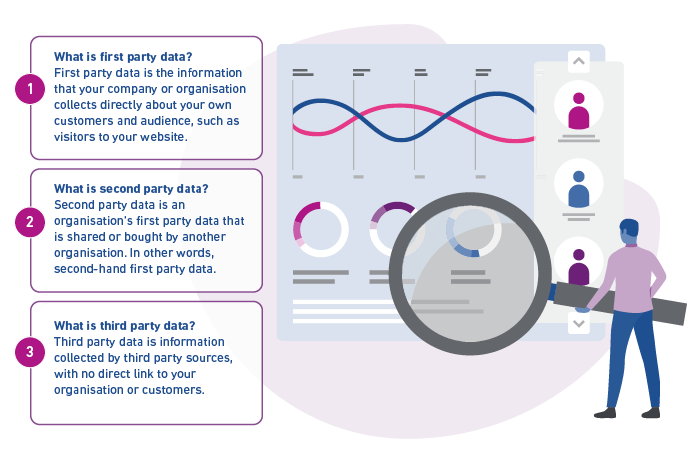What is first party, second party, and third party data? Marketing data explained
Understanding data-driven marketing in a rapidly changing, privacy-centric world
Analysis, insight, and evaluation make data powerful. So much so that data has quickly become a marketer’s most valuable asset.
By collecting, analysing, and combining first, second, and third-party data, brands and businesses can get access to powerful audience insights to understand and predict consumer behaviour, identify future trends, and ultimately drive higher conversions.
You can also gain deeper insights into existing customers and prospects, to build personalised experiences and optimise campaigns based on accurate, relevant and timely information. From completing customer profiles to fill important data gaps, to segmenting your target audience for more effective target marketing.
In this article we look at what first, second and third party data are and how combining them can create a powerful marketing combination. We also explore what the phase-out[1] of third party cookies, driven by consumers’ data privacy concerns and regulatory changes, means for data-driven marketing.
What is first party data?
First party data is the information that your company or organisation collects directly about your own customers and audience, such as visitors to your website.
What is first party data?
First party data is the information that your company or organisation collects directly about your own customers and audience, such as visitors to your website.
It’s collected through all the ways your customers and audience interact with you. Via platforms like your website, social media and mobile apps, which use embedded tracking pixels to record and collect audience actions, as well as customer transaction histories, loyalty programmes and other direct touchpoints like email marketing. For example, embedded tracking pixels show you when an individual has interacted with a specific product or piece of content.
Alongside this is the data which customers voluntarily share with you, referred to by some marketers as “zero party data”. For instance, information collected via customer surveys and website polls.
This data is owned by you and provides invaluable insight into customer and audience demographics, browsing patterns, buying behaviour, shopping preferences and contact details – giving marketers a great advantage.
Because first party data is collected directly from your customers and audience, it’s considered reliable and can be used to drive important business decisions and enhancements to the customer journey.
What is second party data?
Second party data is an organisation’s first party data that is shared or bought by another organisation. In other words, second-hand first party data.
What is second party data?
Second party data is an organisation’s first party data that is shared or bought by another organisation. In other words, second-hand first party data.
It involves a direct partnership or a data-sharing agreement between the two organisations. For example, a retailer may partner with a complementary business to access their data for joint marketing campaigns. It also includes services like Google Affinity audiences, which enables marketers to benefit from the user data Google collects to identify a wider audience based on shared characteristics, such as interests.
Although second party data doesn’t come directly from your own customers and audience, it can be a useful way to enhance and build on your first party data. From broadening your insight into evolving consumer behaviour and trends to improve the customer journey, to targeting new audiences similar to your existing customer base.
What is third party data?
Third party data is information collected by third party sources, with no direct link to your organisation or customers. Contrary to popular belief, it’s not a list of contacts available to buy, but specific and analysed data sets packaged and designed to enhance the customer view and your first party data insights.
What is third party data?
Third party data is information collected by third party sources, with no direct link to your organisation or customers.
For instance, organisations often buy third party data sets to build customer and audience profiles, gain wider intelligence from an outside perspective and insights not found in first party data, and fill-in important first party data gaps.
Common examples of third party data include user feedback, website interactions, focus group responses, and purchase history analysis. Businesses and brands can obtain third-party data from data providers, marketplaces and brokers.
Online third party data insights are based on consumer behaviour monitored by third party cookies and trackers, embedded onto host platforms such as websites and mobile apps by external organisations. However, third party cookies are due to be phased out from 2024 onwards, driven by consumers’ data privacy concerns and regulatory changes.
It’s important to note that the outcomes and strategies around the phase-out of third party cookies will vary across markets and sectors, with organisations including data providers and advertisers still actively exploring and adapting to these changes. Brands and businesses will need to monitor developments, embrace privacy-centric alternatives, and adapt their marketing strategies to navigate the evolving landscape around regulation and consumer behaviour.

5 reasons why third party data is still important to marketers
Despite third party cookies being phased-out, third party data will still have a role to play in marketing. Here are some of the ways it could benefit your business or brand.
- Audience expansion and targeting
Third party data can help you reach and target new audiences beyond your existing customer data. It gives you access to a larger pool of data from a larger range of sources, enabling you to identify potential customers with similar characteristics to your target audience, such as interests and habits. This can be particularly useful for brands and businesses looking to expand into new markets or industries.
- Audience expansion and targeting
- Enriching customer profiles
Third party data can enhance your understanding of customer segments by providing additional insights and attributes, including those not readily available via first party data.
It can supplement existing customer profiles with demographic, behavioural and psychographic information such as consumers’ interests, values, goals, and lifestyle choices. Enabling you to personalise your marketing campaigns and segment customers into specific groups at a deeper, more granular level.
- Market research and trend analysis
When it comes to market research, third party data can be valuable for providing broader insights into industry trends, competitive landscapes, and consumer behaviour. It can help marketers to identify emerging patterns, preferences, and opportunities, enabling you to make informed strategic decisions and stay competitive in the market.
- Testing and validation
Marketers can leverage third party data to run pilot campaigns, conduct A/B testing to improve user experience, or validate assumptions – before investing heavily in activities and resources. Being able to test and validate marketing strategies, campaigns, and hypotheses will enable you to make more cost-effective, data-driven decisions.
- Cross channel and cross device targeting
Third party data can also help marketers bridge gaps between different channels and devices. It enables cross-channel targeting by providing insights into consumer behaviour across various touchpoints, allowing marketers to deliver consistent and coordinated experiences across platforms.
The power of combining first, second and third party data
By combining all three types of data, you can build a solid foundation for audience data analysis and targeting, helping you to understand which audiences to focus your resources and marketing budgets on. While first party data provides insights into your existing customers and audience, second and third party data offers deeper, additional insights and visibility of potential new customers.
We’ve identified four key stages to help you navigate the evolving world of data-driven marketing across channels and devices, alongside changing consumer attitudes and buying behaviours:
- Understand your customers: Use data and insights to understand your most valuable customers now, and how they may evolve in the future. Segmentation and analysis drive increased understanding and clarity.
- Segment your audiences: Use first, second and third party data to segment your target audiences and understand their affinity to your products and services. This is key to effective audience planning and buying in all channels.
- Optimise in channel: Use a combination of data points to modify buying strategy and improve performance against agreed KPIs.
- Evaluate and refine: Constantly evaluate campaign performance against audiences and channels to optimise your current campaigns and future campaign planning.
How can we help?
Whether you’re initiating a strategic customer insights project, product launch or marketing campaign, talk to us about how our data and insights can better support you in achieving the best outcomes for your marketing initiatives and ultimately, your clients.
We can help you identify your best customers, find more of them, and then coordinate seamless and intelligent interactions across the most appropriate channels. For example, our segmentation solutions such as Experian Mosaic and WorldView can help you to deepen customer loyalty, strengthen brand advocacy and maximise profits.
Being effective across all channels – from traditional offline to digital TV and online display – our consumer insights enable accurate and consistent targeting, so consumers receive content that’s relevant to them.










